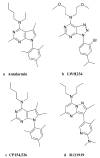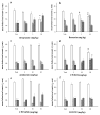The effects of CRF antagonists, antalarmin, CP154,526, LWH234, and R121919, in the forced swim test and on swim-induced increases in adrenocorticotropin in rats
- PMID: 15696320
- PMCID: PMC1315297
- DOI: 10.1007/s00213-005-2164-z
The effects of CRF antagonists, antalarmin, CP154,526, LWH234, and R121919, in the forced swim test and on swim-induced increases in adrenocorticotropin in rats
Abstract
Rationale: Exposure to extreme stress has been suggested to produce long-term, detrimental alterations in the hypothalamic-pituitary-adrenal (HPA) axis leading to the development of mental disorders such as depression. Therefore, compounds that block the effects of stress hormones were investigated as potential therapeutics for depression.
Objectives: In the present study, we compared the potential antidepressant-like effects of four CRF antagonists, antalarmin, CP154,526, R121919, and LWH234 (at 3, 10, and 30 mg/kg i.p., 60 min prior to the forced swim test) and the corresponding effect on swim-induced HPA activation to better elucidate the relation between HPA activity and antidepressant activity.
Methods: The antidepressant-like effects of the CRF antagonists and known antidepressants were determined in the rat forced swim test, and blood samples were obtained before and after swimming for the evaluation of adrenocorticotropin-releasing hormone (ACTH) levels.
Results: Antalarmin, CP154,526, and R121919 did not produce antidepressant-like effects in the forced swim test although these compounds decreased swim-induced increases in ACTH to various extents. In contrast, LWH234 reduced immobility in the forced swim test, without altering the swim-stress-induced ACTH response. However, this compound antagonized restraint-induced ACTH release.
Conclusions: These data suggest that reducing stress-induced increases in HPA activity alone may not be sufficient to produce antidepressant-like activity; however, reductions in HPA activity may contribute to antidepressant actions of some treatments. In addition, it is proposed that CRF antagonists may alter differentially the HPA axis depending on the type of stressor used or behavioral measure evaluated.
Figures




Similar articles
-
Antidepressant-like effect of geniposide on chronic unpredictable mild stress-induced depressive rats by regulating the hypothalamus-pituitary-adrenal axis.Eur Neuropsychopharmacol. 2015 Aug;25(8):1332-41. doi: 10.1016/j.euroneuro.2015.04.009. Epub 2015 Apr 17. Eur Neuropsychopharmacol. 2015. PMID: 25914157
-
Corticotropin-releasing hormone antagonists, astressin B and antalarmin: differing profiles of activity in rhesus monkeys.Neuropsychopharmacology. 2004 Jun;29(6):1112-21. doi: 10.1038/sj.npp.1300410. Neuropsychopharmacology. 2004. PMID: 14997174
-
Psychostimulants and forced swim stress interaction: how activation of the hypothalamic-pituitary-adrenal axis and stress-induced hyperglycemia are affected.Psychopharmacology (Berl). 2017 Oct;234(19):2859-2869. doi: 10.1007/s00213-017-4675-9. Epub 2017 Jul 14. Psychopharmacology (Berl). 2017. PMID: 28710520
-
An overview of SSR149415, a selective nonpeptide vasopressin V(1b) receptor antagonist for the treatment of stress-related disorders.CNS Drug Rev. 2005 Spring;11(1):53-68. doi: 10.1111/j.1527-3458.2005.tb00035.x. CNS Drug Rev. 2005. PMID: 15867952 Free PMC article. Review.
-
[Interaction of 5-HT and HPA axis in depression and treatment-resistant depression].Nihon Yakurigaku Zasshi. 2002 Jun;119(6):319-25. doi: 10.1254/fpj.119.319. Nihon Yakurigaku Zasshi. 2002. PMID: 12089903 Review. Japanese.
Cited by
-
Chinese Herbal Medicine for the Treatment of Depression: Effects on the Neuroendocrine-Immune Network.Pharmaceuticals (Basel). 2021 Jan 14;14(1):65. doi: 10.3390/ph14010065. Pharmaceuticals (Basel). 2021. PMID: 33466877 Free PMC article. Review.
-
Sex differences in corticotropin-releasing factor receptor-1 action within the dorsal raphe nucleus in stress responsivity.Biol Psychiatry. 2014 Jun 1;75(11):873-83. doi: 10.1016/j.biopsych.2013.10.013. Epub 2013 Oct 23. Biol Psychiatry. 2014. PMID: 24289884 Free PMC article.
-
Individual differences in reactivity to social stress predict susceptibility and resilience to a depressive phenotype: role of corticotropin-releasing factor.Endocrinology. 2010 Apr;151(4):1795-805. doi: 10.1210/en.2009-1026. Epub 2010 Feb 16. Endocrinology. 2010. PMID: 20160137 Free PMC article.
-
Effects of antalarmin, a CRF receptor 1 antagonist, on fright reaction and endocrine stress response in crucian carp (Carassius carassius).J Comp Physiol A Neuroethol Sens Neural Behav Physiol. 2008 Dec;194(12):1007-12. doi: 10.1007/s00359-008-0372-9. Epub 2008 Oct 2. J Comp Physiol A Neuroethol Sens Neural Behav Physiol. 2008. PMID: 18830607
-
A final common pathway for depression? Progress toward a general conceptual framework.Neurosci Biobehav Rev. 2008;32(3):508-24. doi: 10.1016/j.neubiorev.2007.08.007. Epub 2007 Oct 10. Neurosci Biobehav Rev. 2008. PMID: 18023876 Free PMC article. Review.
References
-
- Alonso R, Griebel G, Pavone G, Stemmelin J, Le Fur G, Soubrié P. Blockade of CRF1 and V1b receptors reverses stress-induced suppression of neurogenesis in a mouse model of depression. Mol Psychiatry. 2004;9:278–286. - PubMed
-
- Borsini F, Lecci A, Sessarego A, Frassine R, Meli A. Discovery of antidepressant activity by forced swimming test may depend on pre-exposure of rats to a stressful situation. Psychopharmacology. 1989;97:183–188. - PubMed
-
- Britton DR, Varela M, Garcia A, Rosenthal M. Dexamethasone suppresses pituitary–adrenal but not behavioral effects of centrally administered CRF. Life Sci. 1986a;38(3):211–216. - PubMed
-
- Britton DR, Lee G, Dana R, Risch SC, Koob GF. Activating and ‘anxiogenic’ effects of corticotropin releasing factor are not inhibited by blockade of the pituitary–adrenal system with dexamethasone. Life Sci. 1986b;39(14):1281–1286. - PubMed
-
- Broadbear JH, Winger G, Rivier JE, Rice KC, Woods JH. Corticotropin-releasing hormone antagonists, astressin B and antalarmin: differing profiles of activity in rhesus monkeys. Neuropsychopharmacology. 2004;29:1112–1121. - PubMed
Publication types
MeSH terms
Substances
Grants and funding
LinkOut - more resources
Full Text Sources
Medical

